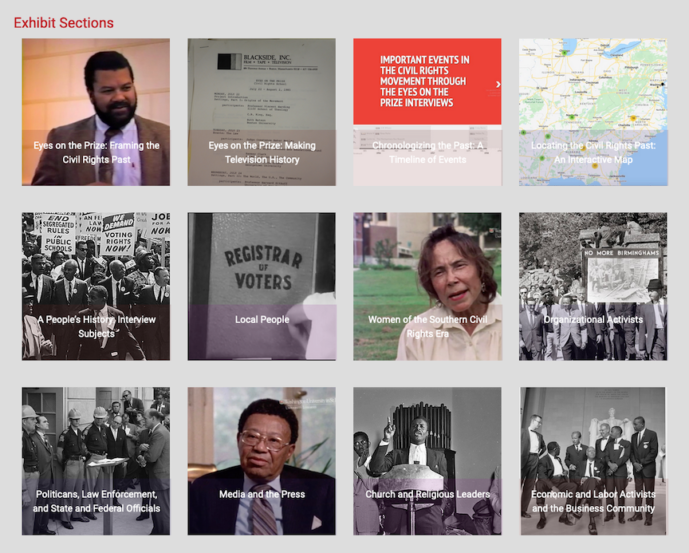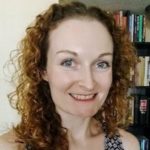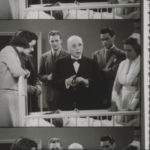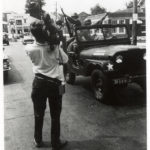Looking Again at Eyes on the Prize
The civil rights era in the United States was a time of great upheaval, of continuing and at times intensified injustice, and of both triumph and tragedy.
Beginning in 1987, a celebrated television series, Eyes on the Prize, detailed the era with extraordinary footage and interviews with a vast assortment of figures who played roles in the tumult.
Now the Boston-based American Archive of Public Broadcasting (AAPB) has released a new online exhibit – Freedom Song: Interviews from Eyes on the Prize: America’s Civil Rights Years, 1954–1965 – that explores what went into making the groundbreaking civil rights series.
The Freedom Song exhibit uses unedited interviews that were recorded for the series, as well as an interactive map of locations central to the civil rights movement, along with a timeline of critical events.
The Freedom Song exhibit is designed to breathe new life and context into the epic series produced by filmmaker Henry Hampton’s production company, Blackside Inc.
In 2001, Civil Rights Project Inc., Blackside’s nonprofit affiliate, donated the materials used to create Hampton’s films to Washington University’s Film & Media Archive, while the AAPB is a collaboration between the Library of Congress and Boston public media producer GBH to preserve and make accessible historically significant at-risk public media.
“We’re fortunate to have at our fingertips the voices and testimony of the people who made the Civil Rights Movement a reality, as well as the history of the Eyes on the Prize filmmakers who helped shape their stories to preserve for future generations,” said the exhibit’s curator, Michelle Kelley, a cinema studies scholar who worked with students on the Eyes on the Prize interviews as a postdoctoral teaching fellow at Washington University in St. Louis, Missouri.
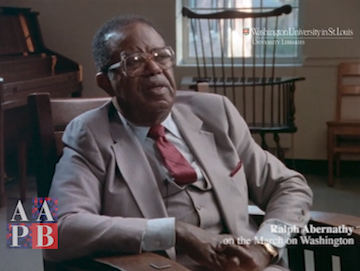
Images: Freedom Song
Eyes on the Prize was a 14-part series which screened in two parts on PBS stations in 1985 and 1988. The series is widely considered the definitive documentary on the Civil Rights Movement. It won numerous major awards and was viewed by more than 20 million people.
“I’m proud to be able to contribute to the Eyes on the Prize legacy through in-depth study of these interviews with students at WashU and with this special exhibit for the American Archive of Public Broadcasting,” Kelley said.
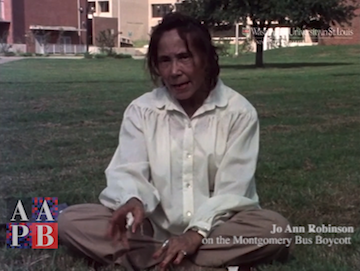 Hampton and his colleagues recorded hundreds of hours of interviews for Eyes on the Prize, far more than they could include in the PBS broadcasts. Only a fraction made the cut of the final series. In 2001, Civil Rights Project Inc., Blackside’s nonprofit affiliate, donated the materials used to create Hampton’s films to Washington University Libraries’ Film & Media Archive. The Washington U archive preserved and digitized the interviews with funding from the Andrew W. Mellon Foundation, the National Historical Publications and Records Commission, and the National Endowment for the Humanities.
Hampton and his colleagues recorded hundreds of hours of interviews for Eyes on the Prize, far more than they could include in the PBS broadcasts. Only a fraction made the cut of the final series. In 2001, Civil Rights Project Inc., Blackside’s nonprofit affiliate, donated the materials used to create Hampton’s films to Washington University Libraries’ Film & Media Archive. The Washington U archive preserved and digitized the interviews with funding from the Andrew W. Mellon Foundation, the National Historical Publications and Records Commission, and the National Endowment for the Humanities.
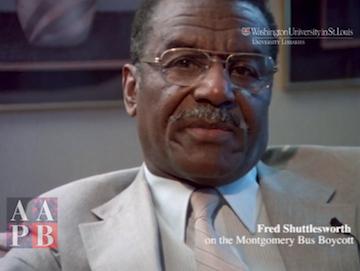 Kelley, as curator of the new exhibit, had access to 127 raw interviews preserved from Eyes on the Prize: America’s Civil Rights Years 1954 -1965, as well as from America, They Loved You Madly, a never-broadcast precursor to Eyes on the Prize. (Soon, the AAPB will make available a second set of unedited interviews, Eyes on the Prize II: America at the Racial Crossroads, 1965 – 1985, from the second phase of the original television series.)
Kelley, as curator of the new exhibit, had access to 127 raw interviews preserved from Eyes on the Prize: America’s Civil Rights Years 1954 -1965, as well as from America, They Loved You Madly, a never-broadcast precursor to Eyes on the Prize. (Soon, the AAPB will make available a second set of unedited interviews, Eyes on the Prize II: America at the Racial Crossroads, 1965 – 1985, from the second phase of the original television series.)
She opted to use full, unedited interviews in the new exhibit. The Washington University Libraries restored them from original films and contributed them to the American Archive of Public Broadcasting to increase understanding of the lived experiences of the array of interviewees. Those included not only proponents of change, such as civil rights leaders and activists, along with journalists, politicians, and clergy, but also opponents of it — segregationists and the like.
The present moment, amidst continuing demands for racial justice in the United States from advocates of Black Lives Matter and a vast array of others, is a particularly apt time for a revival of the representations and demands of the Civil Rights era, said Alan Gevinson, AAPB project director at the Library of Congress: “We see powerful echoes of the Civil Rights Movement in our present drive for social justice and the fight against systemic racism. Because of Henry Hampton’s singular mission to preserve and elevate the grassroots stories of history’s change makers, in addition to those of the movement’s leaders, we have a rare opportunity to learn from this dynamic archive of material and from Dr. Kelley’s expertise on elements that came together to make Eyes on the Prize a reality.”
In another acknowledgment of the timeliness of the AAPB Freedom Song exhibit project, it — along with media partners WORLD Channel (a national public media broadcast, online, and social media platform) and PBS — will bring US viewers a repeat television run of the 14-part Eyes on the Prize, starting this weekend (4 April 2021).
The Freedom Song exhibit provides several ways to explore the Eyes on the Prize interviews: by episode, by historical event, by place, and by interviewees’ roles during the southern Civil Rights era.
An interactive timeline directs viewers to which interviewees discuss specific events in Civil Rights history.
The interactive map displays places of importance referenced in the interviews with links back to the source material.
Among the interviews are many key figures, such as John Lewis, Coretta Scott King, Rosa Parks, and Bayard Rustin, but also many who are less well known, today.
Kelley curated, and Kenneth Campbell, a Howard University graduate student and documentary filmmaker, produced and edited, a 20-minute clip compilation of key interview highlights.
“The preservation of the Eyes on the Prize interviews is a critical step toward making these pivotal moments in civil rights history accessible to all,” said Nadia Ghasedi, Washington University Libraries associate university librarian for Special Collections Services. She called the Freedom Song exhibit “a thoughtful guide to this vast archive of primary sources” and “a much-needed resource for scholars, students, and the public.”
– from press release and research
Previous Post: Hagley Library’s Collection Tells How Industry Worked
Next Post: A Curtain Tells of a Town's Cinema History

